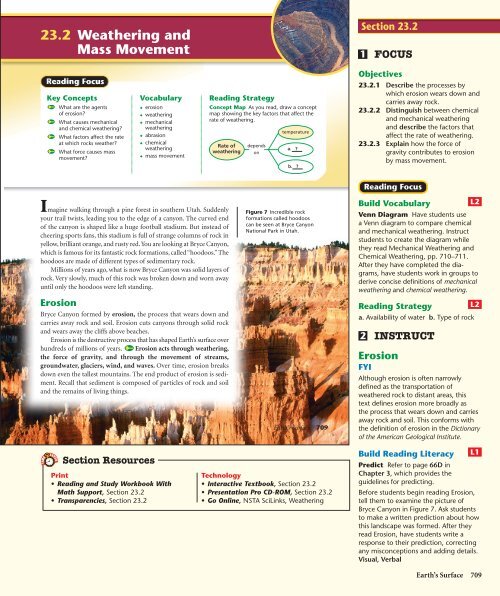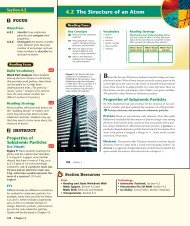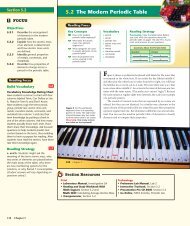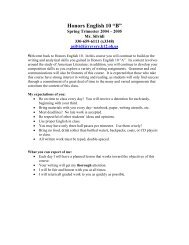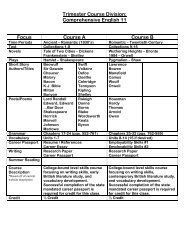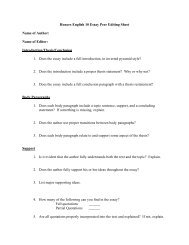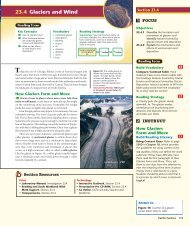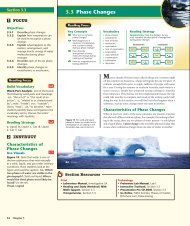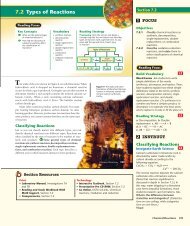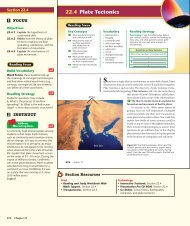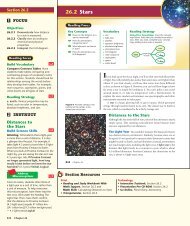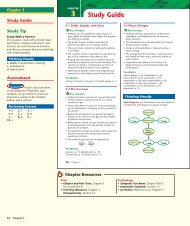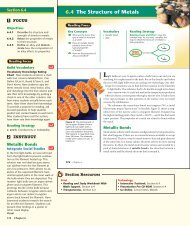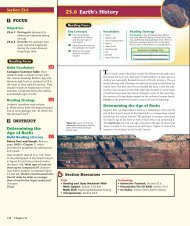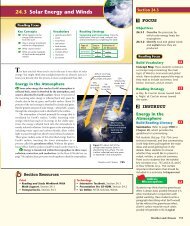23.2 Weathering and Mass Movement
23.2 Weathering and Mass Movement
23.2 Weathering and Mass Movement
Create successful ePaper yourself
Turn your PDF publications into a flip-book with our unique Google optimized e-Paper software.
<strong>23.2</strong> <strong>Weathering</strong> <strong>and</strong><br />
<strong>Mass</strong> <strong>Movement</strong><br />
Key Concepts<br />
What are the agents<br />
of erosion?<br />
What causes mechanical<br />
<strong>and</strong> chemical weathering?<br />
What factors affect the rate<br />
at which rocks weather?<br />
What force causes mass<br />
movement?<br />
Vocabulary<br />
◆ erosion<br />
◆ weathering<br />
◆ mechanical<br />
weathering<br />
◆ abrasion<br />
◆ chemical<br />
weathering<br />
◆ mass movement<br />
Reading Strategy<br />
Concept Map As you read, draw a concept<br />
map showing the key factors that affect the<br />
rate of weathering.<br />
Rate of<br />
weathering<br />
Imagine walking through a pine forest in southern Utah. Suddenly<br />
your trail twists, leading you to the edge of a canyon. The curved end<br />
of the canyon is shaped like a huge football stadium. But instead of<br />
cheering sports fans, this stadium is full of strange columns of rock in<br />
yellow, brilliant orange, <strong>and</strong> rusty red. You are looking at Bryce Canyon,<br />
which is famous for its fantastic rock formations, called “hoodoos.” The<br />
hoodoos are made of different types of sedimentary rock.<br />
Millions of years ago, what is now Bryce Canyon was solid layers of<br />
rock. Very slowly, much of this rock was broken down <strong>and</strong> worn away<br />
until only the hoodoos were left st<strong>and</strong>ing.<br />
Erosion<br />
Bryce Canyon formed by erosion, the process that wears down <strong>and</strong><br />
carries away rock <strong>and</strong> soil. Erosion cuts canyons through solid rock<br />
<strong>and</strong> wears away the cliffs above beaches.<br />
Erosion is the destructive process that has shaped Earth’s surface over<br />
hundreds of millions of years. Erosion acts through weathering,<br />
the force of gravity, <strong>and</strong> through the movement of streams,<br />
groundwater, glaciers, wind, <strong>and</strong> waves. Over time, erosion breaks<br />
down even the tallest mountains. The end product of erosion is sediment.<br />
Recall that sediment is composed of particles of rock <strong>and</strong> soil<br />
<strong>and</strong> the remains of living things.<br />
Section Resources<br />
Print<br />
• Reading <strong>and</strong> Study Workbook With<br />
Math Support, Section <strong>23.2</strong><br />
• Transparencies, Section <strong>23.2</strong><br />
depends<br />
on<br />
temperature<br />
a. ?<br />
b. ?<br />
Figure 7 Incredible rock<br />
formations called hoodoos<br />
can be seen at Bryce Canyon<br />
National Park in Utah.<br />
Earth’s Surface 709<br />
Technology<br />
• Interactive Textbook, Section <strong>23.2</strong><br />
• Presentation Pro CD-ROM, Section <strong>23.2</strong><br />
• Go Online, NSTA SciLinks, <strong>Weathering</strong><br />
Section <strong>23.2</strong><br />
1<br />
FOCUS<br />
Objectives<br />
<strong>23.2</strong>.1 Describe the processes by<br />
which erosion wears down <strong>and</strong><br />
carries away rock.<br />
<strong>23.2</strong>.2 Distinguish between chemical<br />
<strong>and</strong> mechanical weathering<br />
<strong>and</strong> describe the factors that<br />
affect the rate of weathering.<br />
<strong>23.2</strong>.3 Explain how the force of<br />
gravity contributes to erosion<br />
by mass movement.<br />
Build Vocabulary<br />
Venn Diagram Have students use<br />
a Venn diagram to compare chemical<br />
<strong>and</strong> mechanical weathering. Instruct<br />
students to create the diagram while<br />
they read Mechanical <strong>Weathering</strong> <strong>and</strong><br />
Chemical <strong>Weathering</strong>, pp. 710–711.<br />
After they have completed the diagrams,<br />
have students work in groups to<br />
derive concise definitions of mechanical<br />
weathering <strong>and</strong> chemical weathering.<br />
Reading Strategy<br />
a. Availability of water b. Type of rock<br />
2<br />
Reading Focus<br />
INSTRUCT<br />
Erosion<br />
FYI<br />
Although erosion is often narrowly<br />
defined as the transportation of<br />
weathered rock to distant areas, this<br />
text defines erosion more broadly as<br />
the process that wears down <strong>and</strong> carries<br />
away rock <strong>and</strong> soil. This conforms with<br />
the definition of erosion in the Dictionary<br />
of the American Geological Institute.<br />
Build Reading Literacy<br />
L2<br />
L2<br />
L1<br />
Predict Refer to page 66D in<br />
Chapter 3, which provides the<br />
guidelines for predicting.<br />
Before students begin reading Erosion,<br />
tell them to examine the picture of<br />
Bryce Canyon in Figure 7. Ask students<br />
to make a written prediction about how<br />
this l<strong>and</strong>scape was formed. After they<br />
read Erosion, have students write a<br />
response to their prediction, correcting<br />
any misconceptions <strong>and</strong> adding details.<br />
Visual, Verbal<br />
Earth’s Surface 709
Section <strong>23.2</strong> (continued)<br />
<strong>Weathering</strong><br />
Chemical <strong>Weathering</strong><br />
Purpose Students observe how rock<br />
can be broken down by a chemical<br />
reaction.<br />
Materials calcite, 1M HCl, dropper<br />
Procedure Tell students that calcite is<br />
particularly susceptible to chemical<br />
weathering by acidic solutions such as<br />
rain. Explain that rain contains sulfuric<br />
<strong>and</strong> nitric acids, <strong>and</strong> can be strongly<br />
acidic in areas of heavy pollution.<br />
Buildings <strong>and</strong> other structures made of<br />
marble <strong>and</strong> other calcite-containing<br />
stone exhibit severe chemical<br />
weathering over a period of years in<br />
regions where acid rain is a common<br />
problem. Ask, What do you think will<br />
happen when I drip acid on the rock?<br />
(The calcite crystals will react with the<br />
acid.) Drip a few drops on the rock,<br />
being sure to hit calcite crystals.<br />
Expected Outcome The calcite<br />
crystals will fizz <strong>and</strong> bubble.<br />
Visual<br />
Download a worksheet on<br />
weathering for students to<br />
complete, <strong>and</strong> find additional<br />
teacher support from NSTA SciLinks.<br />
710 Chapter 23<br />
L2<br />
Figure 8 When water exp<strong>and</strong>s to<br />
form ice, it can pry open cracks in<br />
rock. This is called frost wedging.<br />
Classifying Is frost wedging a<br />
form of mechanical weathering<br />
or chemical weathering?<br />
For: Links on weathering<br />
Visit: www.SciLinks.org<br />
Web Code: ccn-3232<br />
710 Chapter 23<br />
Customize for Inclusion Students<br />
Gifted<br />
Have students collect rain samples from<br />
around their homes or the school, <strong>and</strong> use<br />
litmus paper or a pH meter to measure the pH<br />
of the rain in your area. Tell students to make<br />
sure they place their collection containers<br />
<strong>Weathering</strong><br />
Erosion starts with weathering. <strong>Weathering</strong> is the<br />
process by which rocks are chemically altered or<br />
physically broken down into fragments at or near<br />
Earth’s surface. There are two forms of<br />
weathering: mechanical <strong>and</strong> chemical. They<br />
cause rocks to disintegrate or decompose.<br />
Mechanical <strong>Weathering</strong> Under the right<br />
conditions, even the hardest rock can be broken<br />
into smaller pieces. Mechanical weathering is the<br />
process of physically breaking rock into smaller<br />
fragments. Mechanical weathering occurs through<br />
frost wedging, abrasion, growth of plant roots,<br />
<strong>and</strong> other processes.<br />
The most common form of mechanical weathering<br />
is frost wedging, shown in Figure 8. When<br />
water freezes to form ice, the water exp<strong>and</strong>s. This expansion pries open<br />
any cracks that the water has seeped into. Frost wedging is an important<br />
cause of weathering in mountains, where water often freezes at night<br />
<strong>and</strong> melts during the day. Frost wedging pries rocks apart a little bit<br />
every night. If you live in a region that has cold winters, you may see<br />
how frost wedging damages roads. Many of the potholes that form in<br />
roads during winter are the result in part of frost wedging.<br />
Another form of mechanical weathering, called abrasion, occurs<br />
when rocks scrape or grind against one another. For example, abrasion<br />
occurs when s<strong>and</strong> carried by water or wind causes bits of rock to<br />
break off as if they were being s<strong>and</strong>blasted.<br />
Mechanical weathering also occurs in other ways. Plant roots can<br />
grow into cracks in a rock. Roots exert a powerful force that can<br />
slowly pry the rock apart. In another form of weathering, erosion<br />
removes material from the surface of a mass of rock, reducing pressure<br />
on the rock that remains. This release of pressure allows the rock<br />
to exp<strong>and</strong>, causing the outside of the rock to crack <strong>and</strong> flake off like<br />
layers of pastry.<br />
Chemical <strong>Weathering</strong> Chemical weathering is a process in<br />
which rock is broken down by chemical reactions. Chemical weathering<br />
involves chemical reactions that dissolve the minerals making up<br />
rock or change them into new minerals. Over time, the effects of chemical<br />
weathering can be dramatic. Pits or holes may form in the rock<br />
surface. Eventually, the rock crumbles <strong>and</strong> disintegrates.<br />
Water is the main agent of chemical weathering. Water is an effective<br />
solvent. All minerals dissolve in water, though most do so very slowly.<br />
away from buildings, trees, or other structures<br />
that the rain might run off of before entering<br />
the container. While you are covering chemical<br />
weathering, have students report to the class<br />
on the pH of the rain in your area.
Chemical weathering also occurs because<br />
rain is slightly acidic. Water <strong>and</strong> carbon dioxide<br />
naturally combine to form carbonic acid.<br />
The carbonic acid in rainwater dissolves many<br />
minerals, such as calcite. The statue of the lion<br />
in Figure 9 has been weathered by carbonic<br />
acid in rain. Carbonic acid <strong>and</strong> water react<br />
with other minerals, such as the feldspar in<br />
granite, to produce clay minerals.<br />
Another type of chemical weathering, the<br />
rusting of minerals that are rich in iron,<br />
involves oxidation. This results in the formation<br />
of new minerals that often have a red or<br />
brown color, such as the rusted bicycle in<br />
Figure 9.<br />
What is the main agent of chemical weathering?<br />
Rates of <strong>Weathering</strong><br />
The rate at which mechanical <strong>and</strong> chemical weathering take place<br />
depends on three main factors: temperature, the availability of water,<br />
<strong>and</strong> the type of rock. Chemical weathering occurs more rapidly in<br />
places with high temperatures <strong>and</strong> abundant rainfall. These conditions<br />
generally speed up chemical reactions. For example, granite weathers<br />
slowly in cool regions, but more rapidly in regions that are hot <strong>and</strong> wet.<br />
Mechanical weathering occurs faster in places where temperature conditions<br />
frequently alternate between freezing <strong>and</strong> thawing.<br />
The rate of weathering also depends upon the kind of rock that is<br />
exposed at the surface. Some rocks, such as limestone <strong>and</strong> marble,<br />
undergo rapid chemical weathering. These rocks are composed primarily<br />
of calcite, a mineral that reacts readily with carbonic acid. One<br />
of the tombstones in Figure 10 shows the effects of chemical weathering<br />
on marble. In contrast, the other tombstone is made of slate, which<br />
is composed of minerals, such as quartz <strong>and</strong> mica, that are much more<br />
resistant to chemical weathering than calcite.<br />
Facts <strong>and</strong> Figures<br />
Humans as Agents of Erosion Many<br />
human activities cause or accelerate<br />
weathering. Industrial activity may cause<br />
highly acidic rain that results in more rapid<br />
chemical weathering. Humans also carry out<br />
mechanical weathering by leveling ground<br />
for roads <strong>and</strong> cities <strong>and</strong> by strip mining for<br />
mineral resources. The paving of large tracts<br />
of l<strong>and</strong> causes more severe erosion of<br />
A<br />
Figure 10 Different rocks weather at different<br />
rates. Even though the slate tombstone (right) is<br />
older, it is much less weathered than the marble<br />
one (left). Inferring What type of weathering was<br />
likely responsible for wearing away the lettering<br />
on the marble tombstone?<br />
B<br />
Figure 9 In chemical weathering,<br />
rock is broken down by chemical<br />
reactions. A One form of chemical<br />
weathering occurs through<br />
oxidation. Iron-rich minerals<br />
become rusted like this old bicycle.<br />
B Chemical weathering also<br />
occurs when rainwater dissolves<br />
or reacts with the minerals in<br />
rocks, as with this statue of a lion.<br />
Earth’s Surface 711<br />
adjacent unpaved areas due to the sheeting<br />
action of water. Soil erosion is a major<br />
problem in agricultural areas, as the U.S.<br />
loses billions of tons of topsoil to erosion<br />
each year. It was agricultural practices that<br />
led to the great Dust Bowl of the 1930s.<br />
Deforestation also contributes to erosion,<br />
including devastating mass movements such<br />
as l<strong>and</strong>slides.<br />
Rates of <strong>Weathering</strong><br />
A common misconception is that soil has<br />
always existed in its present form, rather<br />
than being a product of weathering<br />
rocks <strong>and</strong> decaying organic matter. The<br />
weathering of rocks produces sediment,<br />
one of the main components of soil.<br />
Soil-producing sediment is often created<br />
right underneath people’s feet as rain<br />
percolates down into the ground <strong>and</strong><br />
bedrock undergoes chemical weathering.<br />
In addition to sediment, soil also<br />
contains both living <strong>and</strong> decomposing<br />
organisms. Encourage students to look<br />
for examples of weathering rock <strong>and</strong><br />
soil formation in their outdoor activities,<br />
or bring a heavily weathered rock to<br />
class for students to examine. Ask, Why<br />
does soil often contain tiny stone<br />
fragments <strong>and</strong> quartz crystals (s<strong>and</strong>)?<br />
(As rocks undergo weathering, more<br />
reactive minerals break down first, <strong>and</strong><br />
the more stable minerals, such as quartz,<br />
are left behind.) Why is soil different<br />
in different regions? (Both the bedrock<br />
<strong>and</strong> organic material that produce soil are<br />
different in different regions.)<br />
Logical<br />
Build Reading Literacy<br />
Identify Main Ideas/Details Refer<br />
to page 702D in this chapter, which<br />
provides the guidelines for identifying<br />
main ideas <strong>and</strong> details.<br />
Have students read the main topic<br />
sentence (in bold) of Rates of<br />
<strong>Weathering</strong>. Then, ask, Given this<br />
topic sentence, what are the main<br />
ideas that you should look for in this<br />
selection? (How temperature, availability<br />
of water, <strong>and</strong> the type of rock affect the<br />
rate of chemical <strong>and</strong> mechanical weathering)<br />
After reading Rates of <strong>Weathering</strong>,<br />
have students work in groups to create<br />
index cards with brief explanations of<br />
how these factors affect the rate of<br />
weathering.<br />
Verbal, Group<br />
Answer to . . .<br />
Figure 8 Mechanical weathering<br />
Figure 10 Chemical weathering from<br />
acidic precipitation<br />
Water<br />
L2<br />
L1<br />
Earth’s Surface 711
Section <strong>23.2</strong> (continued)<br />
<strong>Mass</strong> <strong>Movement</strong><br />
Build Science Skills<br />
Relating Cause <strong>and</strong> Effect Have<br />
students work in groups to create a<br />
poster showing the cause <strong>and</strong> effect of<br />
each type of mass movement described<br />
on p. 712. Posters should include a<br />
flowchart that describes the conditions<br />
during which the events occur. Portfolio<br />
Use Visuals<br />
Figure 11 Ask, In the top diagram,<br />
what evidence can you see that creep<br />
is occurring? (Displacement of a fence,<br />
road, <strong>and</strong> electric lines) Visual<br />
3<br />
ASSESS<br />
Evaluate<br />
Underst<strong>and</strong>ing<br />
Have students create flowcharts<br />
describing the processes that produced<br />
the formations in Figure 7.<br />
Reteach<br />
Use Figures 8 <strong>and</strong> 9 to review the<br />
differences between chemical <strong>and</strong><br />
mechanical weathering.<br />
Cracked sidewalk: physical change; rusty<br />
nail: chemical change; hard-to-read<br />
marble tombstone: chemical change<br />
If your class subscribes<br />
to the Interactive Textbook, use it to<br />
review key concepts in Section <strong>23.2</strong>.<br />
Answer to . . .<br />
Figure 11 The greater the slope of<br />
the hillside, the greater the amount of<br />
creep or slumping is.<br />
Section <strong>23.2</strong> Assessment<br />
L2<br />
L1<br />
L2<br />
L2<br />
1. Erosion is the process that wears away rock<br />
<strong>and</strong> soil. Agents of erosion include<br />
weathering, the force of gravity, <strong>and</strong> the<br />
movement of streams, groundwater, glaciers,<br />
wind, <strong>and</strong> waves.<br />
2. Both mechanical <strong>and</strong> chemical weathering<br />
are forms of erosion that cause rocks to<br />
disintegrate. Mechanical weathering breaks<br />
rocks into smaller pieces through physical<br />
processes like frost wedging <strong>and</strong> abrasion.<br />
712 Chapter 23<br />
Figure 11 Creep can be caused<br />
by the alternate freezing <strong>and</strong><br />
thawing of water in soil. Slumping<br />
often occurs when soil that is rich<br />
in clay is soaked by water.<br />
Predicting How would the<br />
steepness of the slope of the<br />
hillside affect the amount of<br />
creep or slumping?<br />
Creep<br />
Slumping<br />
Section <strong>23.2</strong> Assessment<br />
Reviewing Concepts<br />
1. What is erosion? List five agents of erosion.<br />
2. How are mechanical weathering <strong>and</strong><br />
chemical weathering similar? How do<br />
they differ?<br />
3. What three factors are most significant in<br />
determining the rate at which rocks weather?<br />
4. How does gravity cause erosion?<br />
5. Identify three processes that cause<br />
mechanical weathering.<br />
6. What is the role of rainwater in<br />
chemical weathering?<br />
712 Chapter 23<br />
Chemical weathering occurs through<br />
chemical reactions that dissolve rock or<br />
convert existing minerals into new minerals.<br />
3. Temperature, the availability of water, <strong>and</strong><br />
the type of rock involved<br />
4. Gravity causes erosion through mass<br />
movement, which is the movement of rock<br />
<strong>and</strong> soil down a slope.<br />
5. Examples include frost wedging, abrasion,<br />
plant roots that pry a rock apart, <strong>and</strong> release<br />
of pressure from erosion of surface material.<br />
<strong>Mass</strong> <strong>Movement</strong><br />
Once weathering loosens particles of rock, the particles, or sediment,<br />
do not stay in the same place. <strong>Mass</strong> movement is the downward movement<br />
of rock <strong>and</strong> soil due to gravity. Through the process of mass<br />
movement, gravity moves loose material down a slope. There are several<br />
types of mass movement.<br />
L<strong>and</strong>slides The rapid movement of large amounts of rock <strong>and</strong> soil<br />
is a l<strong>and</strong>slide. L<strong>and</strong>slides often occur after heavy rains or after earthquakes<br />
loosen materials on a steep slope. L<strong>and</strong>slides that occur on the<br />
sides of mountains can destroy entire towns.<br />
Mudflows Rapid mass movements of soil <strong>and</strong> other sediment<br />
mixed with water are called mudflows. Mudflows tend to occur in areas<br />
where fine sediment has collected in thick layers. When it rains, water<br />
loosens the sediment <strong>and</strong> increases its weight. After a heavy rainfall,<br />
the sediment mixed with water washes down the slope.<br />
Creep Creep occurs when soil gradually moves down a slope. Creep<br />
often occurs because of the formation of ice. Each time the ground<br />
freezes, the soil exp<strong>and</strong>s outward. When the ground thaws, the soil moves<br />
a small distance downhill. Creep, shown in Figure 11, happens so slowly<br />
that it’s hard to notice. But over time the results of creep become evident.<br />
Slumping Slumping occurs when weak layers of soil or rock suddenly<br />
move downslope as a single unit. Gravity acting on water-saturated soil<br />
<strong>and</strong> rock causes slumping. Slumping often leaves a curved scar.<br />
Critical Thinking<br />
7. Predicting Would you expect chemical<br />
weathering to occur more rapidly in a desert<br />
or in a rainforest? Explain.<br />
8. Relating Cause <strong>and</strong> Effect What conditions<br />
can cause l<strong>and</strong>slides <strong>and</strong> mudflows?<br />
Chemical <strong>and</strong> Physical Changes Use<br />
what you learned in Chapter 2 to classify<br />
each of the following as a chemical or<br />
physical change: a cracked sidewalk, a rusty<br />
nail, a hard-to-read marble tombstone.<br />
6. Rainwater is acidic <strong>and</strong> dissolves many<br />
minerals. Rainwater also reacts with some<br />
minerals to change them into different<br />
minerals.<br />
7. In a rainforest. The greater availability of<br />
water in a rainforest would cause higher rates<br />
of chemical weathering.<br />
8. Heavy rains can loosen sediment <strong>and</strong><br />
increase its weight, increasing the likelihood<br />
of a l<strong>and</strong>slide or mudflow. An earthquake can<br />
also cause these types of mass movement.


